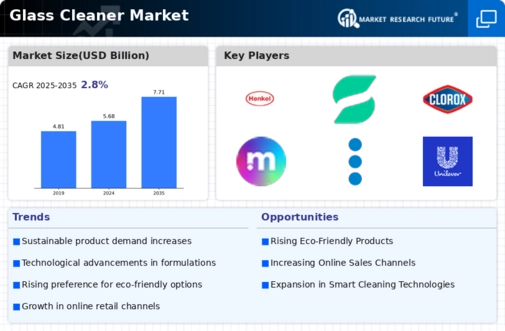Market Trends and Projections
Diverse Applications Across Industries
The Global Glass Cleaner Market Industry is characterized by its diverse applications across various sectors, including automotive, hospitality, and healthcare. Each of these industries requires specialized glass cleaning solutions to maintain aesthetic appeal and hygiene standards. For instance, the automotive sector relies on glass cleaners for vehicle maintenance, while the hospitality industry emphasizes cleanliness to enhance guest experiences. This broad applicability suggests a robust market potential, as companies can tailor their products to meet the specific needs of different sectors. The ongoing diversification of applications is likely to drive sustained growth in the glass cleaner market.
Rising Demand for Eco-Friendly Products
The Global Glass Cleaner Market Industry experiences a notable shift towards eco-friendly cleaning solutions. Consumers increasingly prioritize sustainability, prompting manufacturers to innovate with biodegradable and non-toxic ingredients. This trend aligns with the broader environmental movement, where eco-conscious consumers are willing to pay a premium for green products. As a result, the market is projected to reach 5.68 USD Billion in 2024, reflecting a growing preference for environmentally responsible cleaning agents. Companies that adapt to this demand may gain a competitive edge, potentially capturing a larger market share in the evolving landscape of glass cleaning solutions.
Increased Awareness of Hygiene and Cleanliness
The Global Glass Cleaner Market Industry is witnessing a surge in demand driven by heightened awareness of hygiene and cleanliness. As consumers become more conscious of the importance of maintaining clean environments, the use of glass cleaners has become a routine practice in both homes and workplaces. This trend is particularly evident in public spaces, where cleanliness is paramount. The growing emphasis on hygiene is likely to sustain demand for glass cleaning products, contributing to the market's growth. As a result, manufacturers are encouraged to develop effective and safe cleaning solutions that cater to this increasing consumer focus on cleanliness.
Technological Advancements in Cleaning Solutions
The Global Glass Cleaner Market Industry is significantly influenced by technological advancements that enhance cleaning efficiency. Innovations such as spray-and-wipe formulations and automated cleaning devices are becoming increasingly prevalent. These advancements not only improve the user experience but also reduce the time and effort required for cleaning tasks. As consumers seek convenience and effectiveness, the market is poised for growth. The anticipated compound annual growth rate of 2.82% from 2025 to 2035 indicates a positive outlook for companies that invest in research and development to create cutting-edge glass cleaning products that meet evolving consumer needs.
Growth in Residential and Commercial Construction
The Global Glass Cleaner Market Industry benefits from the ongoing expansion in both residential and commercial construction sectors. As new buildings emerge, the need for effective glass cleaning solutions escalates. This growth is driven by urbanization and increased disposable income, leading to more households and businesses investing in high-quality glass installations. Consequently, the market is expected to grow, with projections indicating a rise to 7.71 USD Billion by 2035. This upward trajectory suggests that as construction activities continue to flourish, the demand for glass cleaners will likely follow suit, creating opportunities for manufacturers and suppliers alike.









